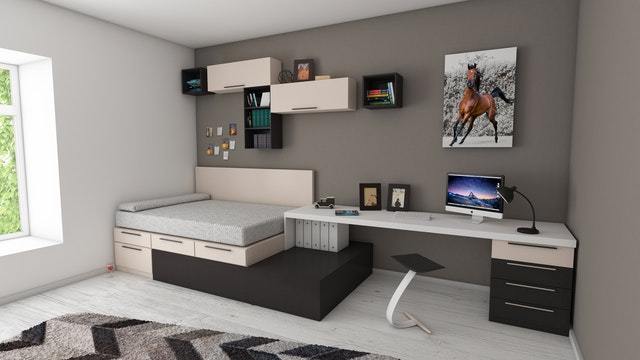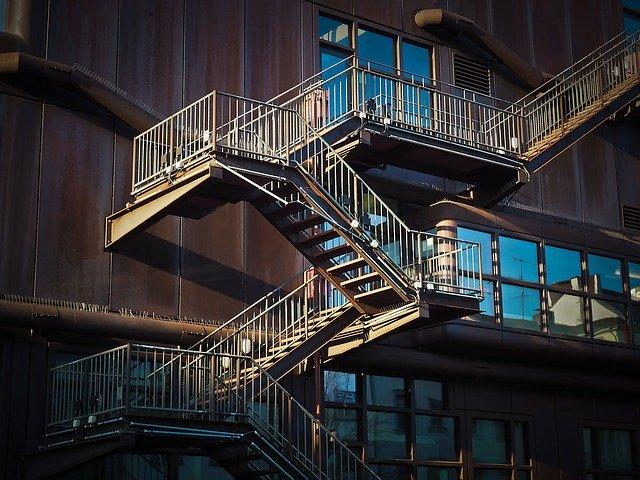
What comes to mind when you hear a false ceiling?
As you might have guessed, a false ceiling is a secondary ceiling referred to as a drop ceiling or bar ceiling. A false ceiling creates a gap between it and the actual ceiling, which provides room for hiding wiring pipes and insulation.
Over the years, the efficiency of the false ceiling for sound absorption has increased significantly. Generally, false ceilings are used for aesthetic purposes, but they also provide excellent thermal insulation and sound absorption.
Some examples of materials used to make false ceiling are P.O.P, gypsum board, plywood, and PVC sheets. These materials have their distinct features and merit.
The Origin of False Ceilings
False ceilings came into existence in the 14th century in Japan. In those days before the advent of electricity, they were mainly installed to add aesthetic value to the home. The reason why they were created was for the beautification of rooms.
The theatre built in England in 1596 marked the first housing in history where a false ceiling was used for an alternative to enhance sound quality.
There weren’t many alternatives available for false ceilings back then, so the material used for its production was substandard. Over the years, there have been significant developments to the application and uses of false ceilings.
Why False Ceilings?
Like a teacup without tea, a building is defective without a decent roof. There are several reasons why false ceilings are preferable; some of the benefits are listed below.
- They are very decorative and serve as an item of beautification in homes
- False ceilings can serve as an instrument for soundproofing and for concealing wires
- They are relatively affordable due to the materials (wood, glass, fiber, or plastic) used in producing them
- The space between a false ceiling and an actual selling accommodates air that is essential for providing a cooler temperature for the room
- A false ceiling is cost-effective and easy to install
- In some cases where the actual ceiling has been damaged or worn out, a false ceiling can be used as a decoy to hide flaws in a real ceiling
- False ceilings are very durable; they last over a long period
Types of False Ceiling
- Plaster of Paris false ceiling
- Wood false ceiling
- Metal false ceiling
Let’s examine them one after the other.
1. Plaster of Paris False Ceiling

Image credit: popfalseceilingcontractor.business.site
The primary component used in the production of Plaster of Paris (POP) is POP powder. The powder is diluted with water, then applied to a framing system that gives it shape or design. A lot of powder is wasted during the production process due to its natural resource nature.
If you ever consider using a POP false ceiling in your room, know that it is time-consuming to install, depending on your choice of design. It can also be very dusty and messy.
Pros
- Weightless and durable
- It is heat resistant. It, therefore, does not promote hot weather
- Its material component is fireproof, and it serves as a good heat insulator
- POP is not prone to cracks or breakage
- It is flexible and can be easily molded into any desired design of choice
- It is absorbent in water, so it is easy to spread and level
- The surface of a POP ceiling is smooth and tender. Thus, it allows for color to settle and beam on it
- Due to its lightweight and transparency, the POP ceiling is one of the best for your lighting systems
Cons
- A POP ceiling is not recommended for an environment with a high moisture level
- The installation requires the service of professionals, especially when designed with special instruments like ornaments
- Too much is wasted in the process of installation due to its refined form
- Maintenance must be regular and constant. It has a limited span of use
- The texture and quality varies, depending on the expertise of the human labor involved in the mixing procedure
2. Wooden False Ceiling

Image credit: spigogroup.com
A wooden false ceiling is produced from well-trimmed, furnished, and the most delicate piece of wood. The ceiling is excellent when it comes to preserving a warm temperature in your home.
Wooden false ceilings are specially optimized to cover wide spaces where many people gather, like an auditorium, cinema, board room, or hospital. This way, the aesthetic composition can be explored maximally.
Pros
- It conceals installations
In places like theatre and shopping malls, the last thing owners want is to piss off audience/customers with electronic devices, air conditioners, and cables scattered here and there. The wooden ceiling is perfect for hiding any distraction from view.
- Artistic value
If you ever desire to flaunt nature’s beauty, carving woods into elegant and stylish pieces of false ceilings can be a stepping stone. People are often wowed by the attractiveness of wooden ceilings, which is why you might find them in places like museums, art galleries, and event centers.
- Flexibility
On any occasion that you want to access your cables for repairs or replacement, you wouldn't need to break your bank to pay professionals to do that. Wooden false ceilings are easily removable and can be assembled by anyone without professional experience.
- Maintenance
The ceilings require little or no pattern of maintenance at all. They last longer than most of the other false ceiling materials.
Cons
- Flammable
Wood is generally known to be volatile. Any incident of fire will be very hard to control.
- Dampness
When a piece of wood is exposed to excessive moisture content, it becomes damp and starts to rot or peel, leading to a loss of quality and aesthetics.
3. Metal False Ceiling

Image credit: justdial.com
Among the best false ceiling options available is the metal false ceiling. Produced from premium quality aluminum sheets with a shining surface that attracts attention in daylight, they make an excellent addition to a stylish home.
Pros
- Durability
Alongside the fascinating appearance, they are incredibly indestructible and have a long life span. Metal ceilings have a high level of resistance and are less likely to rot, crack, or absorb moisture. This means they require zero cost of maintenance and repair.
- Fire-resistant
People are often worried about their safety when considering ceiling options. One outstanding feature of the metal false ceiling is its high degree of fire resistance.
- Simplicity
Installation of metal false ceilings is straightforward. They don’t require any special equipment or knowledge to assemble.
Cons
- Costly materials
Acquiring authentic aluminum material for a metal false ceiling is very expensive. It is one of the most expensive options available; the price ranges from $150 to $600 per square feet. Hence, most people opt for less costly materials like faux-aluminum to save some money.
- It is noisy
In some parts of the world where the atmosphere gets windy, wind can easily blow into the space between the metal false ceiling and the actual ceiling. The noise caused by the wind’s impact on the false ceiling can be very irritating and disturbing.
- Color inconsistency
Since most aluminum sheets are preserved in their naturally occurring color, it is a problem for homes that aren't decorated in colors that match the aluminum sheets. In this case, such homeowners will have to explore other options of materials like wood or POP where the colors can be easily manipulated to suit their desires.
- Lighting system
Metal false ceilings are the least to consider when it comes to embellishment with light bulbs. The reason is that the ceiling isn’t transparent and does not divert the reflection of light into the room. Most times, light bulbs are left hanging from the ceiling, which some homeowners might find very untidy.
Wrap Up
Suppose you fancy beautiful interior designs for your home and workspace, or work as an interior and exterior design expert, it will do a lot of good to carefully consider your options in choosing false ceiling designs for yourself or your client.
You need to answer the questions about where you want the design to be, how much budget you have, and how long you or your client intend to occupy that residence.
Although this article focuses on 3 false ceiling designs, there are several other types of false ceilings like fiber false ceiling, glass false ceiling, PVC false ceiling, fabric false ceiling, and synthetic leather false ceiling.






Leave a comment
This site is protected by hCaptcha and the hCaptcha Privacy Policy and Terms of Service apply.